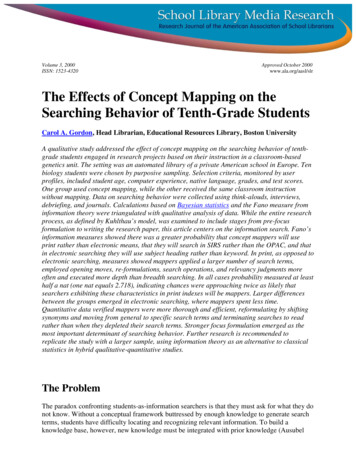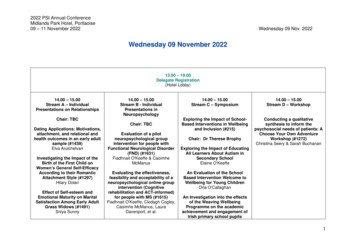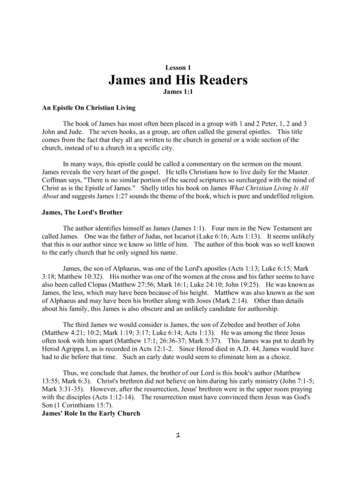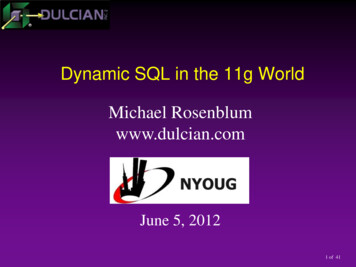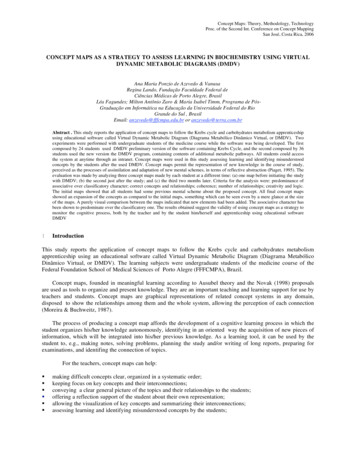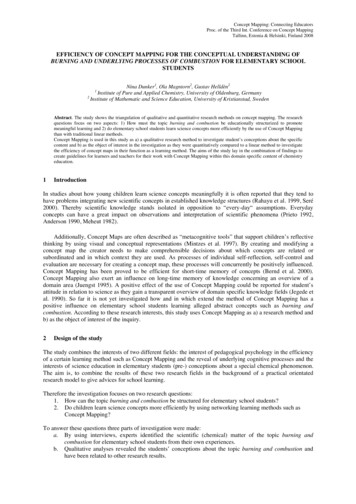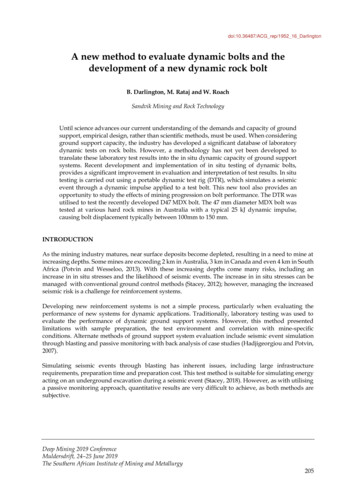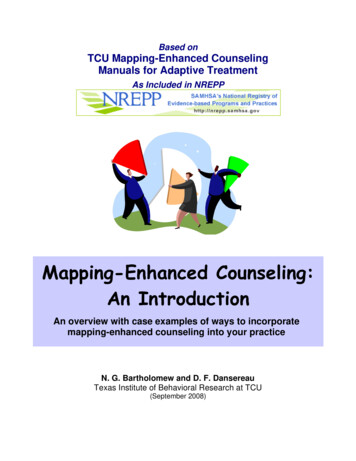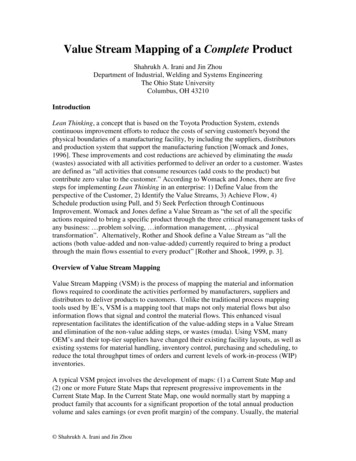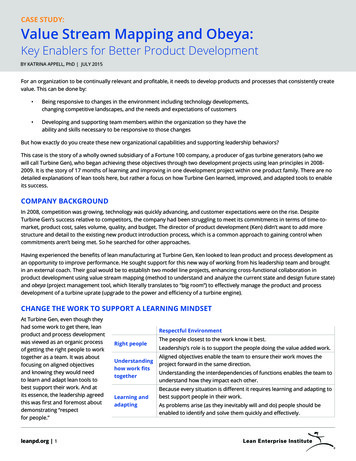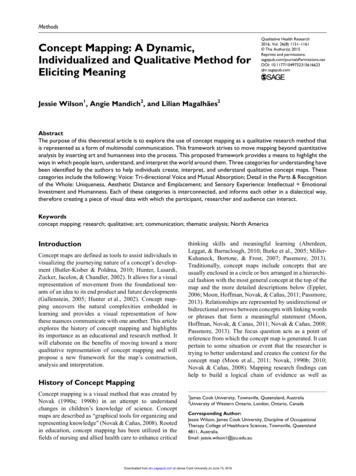
Transcription
616623Qualitative Health ResearchWilson et al.MethodsConcept Mapping: A Dynamic,Individualized and Qualitative Method forEliciting MeaningQualitative Health Research2016, Vol. 26(8) 1151 –1161 The Author(s) 2015Reprints and : 10.1177/1049732315616623qhr.sagepub.comJessie Wilson1, Angie Mandich2, and Lilian Magalhães2AbstractThe purpose of this theoretical article is to explore the use of concept mapping as a qualitative research method thatis represented as a form of multimodal communication. This framework strives to move mapping beyond quantitativeanalysis by inserting art and humanness into the process. This proposed framework provides a means to highlight theways in which people learn, understand, and interpret the world around them. Three categories for understanding havebeen identified by the authors to help individuals create, interpret, and understand qualitative concept maps. Thesecategories include the following: Voice: Tri-directional Voice and Mutual Absorption; Detail in the Parts & Recognitionof the Whole: Uniqueness, Aesthetic Distance and Emplacement; and Sensory Experience: Intellectual EmotionalInvestment and Humanness. Each of these categories is interconnected, and informs each other in a dialectical way,therefore creating a piece of visual data with which the participant, researcher and audience can interact.Keywordsconcept mapping; research; qualitative; art; communication; thematic analysis; North AmericaIntroductionConcept maps are defined as tools to assist individuals invisualizing the journeying nature of a concept’s development (Butler-Kisber & Poldma, 2010; Hunter, Lusardi,Zucker, Jacelon, & Chandler, 2002). It allows for a visualrepresentation of movement from the foundational tenants of an idea to its end product and future developments(Gallenstein, 2005; Hunter et al., 2002). Concept mapping uncovers the natural complexities embedded inlearning and provides a visual representation of howthese nuances communicate with one another. This articleexplores the history of concept mapping and highlightsits importance as an educational and research method. Itwill elaborate on the benefits of moving toward a morequalitative representation of concept mapping and willpropose a new framework for the map’s construction,analysis and interpretation.History of Concept MappingConcept mapping is a visual method that was created byNovak (1990a; 1990b) in an attempt to understandchanges in children’s knowledge of science. Conceptmaps are described as “graphical tools for organizing andrepresenting knowledge” (Novak & Cañas, 2008). Rootedin education, concept mapping has been utilized in thefields of nursing and allied health care to enhance criticalthinking skills and meaningful learning (Aberdeen,Leggat, & Barraclough, 2010; Burke et al., 2005; MillerKuhaneck, Bortone, & Frost, 2007; Passmore, 2013).Traditionally, concept maps include concepts that areusually enclosed in a circle or box arranged in a hierarchical fashion with the most general concept at the top of themap and the more detailed descriptions below (Eppler,2006; Moon, Hoffman, Novak, & Cañas, 2011; Passmore,2013). Relationships are represented by unidirectional orbidirectional arrows between concepts with linking wordsor phrases that form a meaningful statement (Moon,Hoffman, Novak, & Canas, 2011; Novak & Cañas, 2008;Passmore, 2013). The focus question acts as a point ofreference from which the concept map is generated. It canpertain to some situation or event that the researcher istrying to better understand and creates the context for theconcept map (Moon et al., 2011; Novak, 1990b; 2010;Novak & Cañas, 2008). Mapping research findings canhelp to build a logical chain of evidence as well as1James Cook University, Townsville, Queensland, AustraliaUniversity of Western Ontario, London, Ontario, Canada2Corresponding Author:Jessie Wilson, James Cook University, Discipline of OccupationalTherapy College of Healthcare Sciences, Townsville, Queensland4811, Australia.Email: jessie.wilson1@jcu.edu.auDownloaded from qhr.sagepub.com at James Cook University on June 15, 2016
1152Qualitative Health Research 26(8)conceptual and theoretical coherence (Butler-Kisber &Poldma, 2010; Hunter et al., 2002).Epistemological and MethodologicalFoundationsConcept mapping is informed by Ausubel’s (1963, 1968)Assimilation Theory, which suggests that meaningfullearning occurs when there is an assimilation of new concepts into one’s existing knowledge base or “cognitivestructures.” (Ausubel, Novak & Hanesian, 1978) Toensure meaningful learning, the topic must be conceptually clear and presented with examples that are relatableto the learner’s prior knowledge (Moon et al., 2011;Novak, 1990a). The learner must also have a foundationof basic understanding related to the topic and finally, thelearner must choose to learn in a meaningful way(Akinsanya & Williams, 2004; Chiou, 2008; Novak,1990a). “Meaningful learning is the foundation of humanconstructivism which is both a psychological and epistemological phenomenon” (Novak, 1990a, p. 32).The epistemological foundations of concept mappingarise from the constructivist paradigm and are closelylinked with Vee Diagrams or Vee Heuristic developed byNovak’s colleague Gowin (1970, 1981). Gowin’s Veediagrams were created to illustrate the methodologicaland conceptual elements that interact in the process ofnew knowledge construction (Gowin, 1970, 1981;Gowin & Alvarez, 2005; Novak, 1990a; Novak & Cañas,2006, 2008). Vee diagrams help individuals comprehendthe structure and meaning of the knowledge that theyseek to understand (Gowin & Alvarez, 2005; Novak &Gowin, 1984). They are arranged in a “V” and highlightthe underlying conceptual, theoretical and methodological assumptions that are required to construct newknowledge informed by the focus question (Gowin &Alvarez, 2005; Novak, 1990b; 2010; Novak & Cañas,2008).Concept mapping and Vee diagrams are founded onthe understanding that knowledge is constructed amongindividuals. The constructivism paradigm views meaning as constructed by individuals interacting and engaging with the world they are interpreting (Creswell, 2014;Crotty, 2003). Meaning is therefore seen as subjective, asare the concept maps that are created in response tounderstanding a particular question or phenomenon.Concept maps are subjective representations of one’sunderstanding of a concept and are most useful to theperson who creates them (Conceicao & Taylor, 2007;Miller-Kuhaneck et al., 2007). Concept mapping encourages the construction of knowledge in a meaningful wayby facilitating the creative interaction between the individuals, their current cognitive structures and newinformation.Evaluation of Concept MapsHistorically the evaluation of concept maps has compared one map with another. It evaluates the “correctness” of a map by finding commonalities and quantifyingthe number of concepts presented and their relationshipto one another (Davies, 2011; Eppler, 2006; Novak &Cañas, 2008). Novak and Gowin (1984) developed ascoring protocol for analyzing concept maps that evaluates an individual’s map based on quantitative measurements. The number and the arrangement of concepts andthe validity of their linking phrases are pivotal markers inhow well an individual is learning and/or understanding aphenomenon (Chiou, 2008; Conceicao & Taylor, 2007;Kinchin, Hay, & Adams, 2000). A potential barrier toevaluating a concept map solely through a quantitativeapproach limits the descriptive richness and narrows theopportunity to highlight the insights of the participant andresearcher (Kinchin, 2013; Trafimow, 2014). In addition,comparing maps and counting concepts attempts to generalize how individuals learn and disregards the meaningbehind the creation of the map. Establishing a hierarchyamong concepts and instituting validity between linkagesmay cause the researcher to overlook important ideasembedded within the map and minimizes the significanceof the individual’s perspective (Hay, 2007; Kinchin,2013; Kinchin et al., 2000). A body of literature is starting to emerge that explores the use of concept maps as aqualitative research methodology. Through highlightingthe individualized process of concept mapping, it offersthe opportunity to emphasize the humanness and complexity that is inherently embedded within health careresearch.Developing a New FrameworkMultimodality and ArtAccompanying the steps and processes associated withconstructing a sound concept map is an element of creativity. The manner in which an individual constructs hisor her concept map gives clues to his or her values, beliefsand overall approach to research and learning (ButlerKisber & Poldma, 2010; Wheeldon & Faubert, 2009).Concept maps allow the researcher to interact with thedata, uncover new relationships and view the informationfrom a different perspective.The creative component of concept mapping appeals tothe different senses of the individual allowing for a moreholistic learning experience (Butler-Kisber & Poldma, 2010;Taylor & Littleton-Kearney, 2011). Concept maps illustratea form of multimodal communication that allows participants to find and share their voice in new ways. Multimodalcommunication encourages the interaction of multiple semiotic resources such as language, art and photography (KressDownloaded from qhr.sagepub.com at James Cook University on June 15, 2016
1153Wilson et al.& van Leeuwen, 2001, Pink, 2011b; Rose, 2012). Thisapproach to communication allows for the exploration oftheories derived from arts-based disciplines to create newpathways of understanding qualitative data. Eisner (2008)suggests that art is another form of discourse and can be recognized as a specialized form of knowledge. Art as a form ofdiscourse articulates cultural values and beliefs, sheds lighton society structures and allows self-expression beyond therestrictions of textual language (Eisner, 2008; Nead, 1988;Pink, 2011b; Rose, 2012).This article seeks to explore concept mapping as aqualitative research method that is represented as a formof multimodal communication. This framework strives tomove mapping beyond its structure and quantificationthat has been previously discussed in its historical beginnings and seeks to insert art and humanness into the process. The intention is to provide another way to illuminatethe ways in which people learn, understand and interpretthe world around them.Throughout the development of the proposed framework, the researchers were aware of the necessity to haveit strongly rooted in a qualitative methodology.Methodologies encompass both philosophy and methods(Carter & Little, 2007; Finlay & Ballinger, 2006) and laythe foundation for the development of a cohesive researchproject (Howell, 2013). It is therefore necessary to explicitly state the epistemological underpinnings of the framework as it guides the production of the concept mappingmethod. The proposed concept mapping framework isderived from the constructivist–interpretivist paradigmwhich recognizes that the construction of knowledge hasmultiple meanings and subjective realities (Creswell,2014; Denzin, 1994; Finlay & Ballinger, 2006). Theunderstanding derived from this form of concept mapping is within the interpretivist traditionand highlights theway in which “our perceptions and experiences aresocially, culturally, historically and linguistically produced” (Finlay & Ballinger, 2006, p.19).In this proposed framework, the researchers areembedded within the phenomenon they are studying andare informing and are informed by the participant(s) andthe mapping process itself. Reflexivity is therefore animportant skill that needs to be implemented throughoutthe mapping process. It allows researchers to provide atransparent methodological account of the co-construction of knowledge during the research process and deepens their understanding of how they collect, select andinterpret data based on their previous understandings,personal values and beliefs (Creswell, 2014; Denzin,1994; Finlay, 2002; Finlay & Ballinger, 2006).these researchers offers unique insights into variousarts-based qualitative research methodologies and theyilluminate significant aspects of visual methodologiesthat have informed this proposed framework. The workof Bresler (2006) blends the use of artistic experiencewith qualitative research throughout the data collection,data analysis and writing process. This illuminates theinterconnected nature of arts-based inquiry throughoutthe qualitative research study (Bresler, 2006). The workof Bresler (2006) also highlights the tri-directional voiceembedded within arts-based and qualitative research.This concept offers a unique perspective on the importance of qualitative arts-based inquiry on the participant’sunderstanding of themselves beyond conveying meaningto the researcher. The work of Pink (2009) was integratedinto the concept mapping framework because of her focuson the sensory experience of qualitative research. Pink(2009) argues that a multisensory approach is necessaryin learning about, understanding and meaningfully representing complex topics in health care research. The workof Rose (2012) situates visual data as having the samevalue as information obtained from written text andnumerical calculations. In addition, Rose (2012) providesstrategies for interpretation of visual materials that areexplicitly linked to strong theoretically and methodological sound foundations in qualitative research. Refer toTable 1 for the key concepts elicited from the work ofBresler (2006), Pink (2009) and Rose (2012).It is important to acknowledge the dialectical relationship between the work of these three authors. Thecommonalities and connections between their workwere used to expound the categories for constructing,analyzing, and interpreting qualitative concept mapping. These categories were identified through multiplereadings of their books and research papers by the threeresearchers searching for common themes. Thesethemes were independently recorded by each researcher,then further discussed and agreed upon collectively.Refer to Table 2 for the connections uncovering the categories for understanding. The themes and their associated descriptions attended to criteria for worth and rigorin qualitative research through demonstrating multivocality, transparency, self-reflexivity, thick descriptionand aesthetic merit (Tracy, 2013). The collective themeswere highlighted and assimilated into the following categories for understanding that form the foundation ofthis proposed framework. The three categories include:1.2.Categories of UnderstandingThe proposed framework was informed by the work ofBresler (2006), Pink (2009) and Rose (2012). Each of3.Voice: Tri-directional Voice and MutualAbsorption;Detail in the Parts & Recognition of the Whole:Uniqueness, Aesthetic Distance, and Emplacement;andSensory Experience: Intellectual and EmotionalInvestment and Humanness.Downloaded from qhr.sagepub.com at James Cook University on June 15, 2016
1154Qualitative Health Research 26(8)Table 1. Key Concepts Elicited From the Work of Bresler (2006), Pink (2009), and Rose (2012).Bresler (2006)Tri-directional relationshipConnection to phenomenonConnection to selfConnection to audience (p. 53)Soft boundaries and flow of ideas andconcepts (p. 53)Doing and Becoming through estheticencounters (p. 54)Empathetic understanding throughresearch role of emotion in researchand a blending of the affective and therational (p. 54)Aesthetic distanceVoice and a fusion of horizons(p. 55, 57)Taking research to the next level(p. 57)Researcher is a part of the learningprocess/change (p. 59)Links to arts-based practices and waysof knowingPink (2009)Rose (2012)Voice and the message of the participantInterconnection of the senses ina dynamic and non-hierarchicalrelationship (p. 2)Developing ways of knowing bysharing in spaces and places with theparticipants and experiencing thingstogether (p. 2)Opening up opportunities for multipleways of knowing (p. 8)Drawing on a family of methods (p. 9)Collaborative process between theresearcher and the participant (p. 10)Weaving of creative discourses andthen effecting the way that peopleunderstand the world around them(p. 12)Focus on everyday practice such ashousework, laundry, gardening etc.(p. 15)Body as a place of knowing through thesenses (p. 24)Human beings are produced not justborn: greatly influenced by theirexperiences (p. 141)Discourse can be in the form of artwork and other multi-modal works(p. 142)One’s culture influences the artwork/visual methods that are produced(p. 142)Vision and visuality; balance betweenwhat the eye actually physically seesand what our culture/experiences etc.have shape what we do see (p. 2)multimodality in images and theimportance of written text,photographs, drawings, multi-mediarepresentations etc. in informingunderstanding and knowledgeproduction (p. 11)Site of audiencing: different people willunderstand and interpret differentmeanings from the image (p. 22)Source. Bresler (2006), Pink (2009), and Rose (2012).These categories are not isolated from one another butinstead they are interconnected and inform each otherthrough a symbiotic relationship. The conceptualizationof soft boundaries allows for the flow of ideas amongthese domains and mimics the relationship betweenresearch and art-making (Bresler, 2006; Irwin & deCosson, 2004). This proposed framework highlights theimportance of arts-based inquiry and regards artisticpractices as significant forms of scholarly inquiry(Bresler, 2006; Finley & Knowles, 1995; Fox &Geichman, 2001; Sullivan, 2005). Therefore, a blend ofarts-based and qualitative research creates a new platformfor the exploration of concept mapping and its use inhealth care research.VoiceThe voice of the participant should be of primary importance during the concept mapping process. How the participant finds his or her voice and shares his or her story isa unique and individualized process (Banks, 2009; Bresler,2006; Rose, 2012). There are many elements of a participant’s voice that need to be considered when constructing,analyzing and interpreting a concept map. The researcher,participant and audience voice can be interchangeabledepending on the intent of the mapping experience.Tri-directional voice. The tri-directional voice refers to thedialogical relationship that evolves between the individual,the concept map and the audience (Bresler, 2006). In visualmethodologies, audiencing is referred to as the process bywhich an image’s meanings are interpreted and understoodby individuals in various contexts (Banks, 2009; Rose,2012). In this proposed framework, the researchers extendthe audiencing inward and recognize the individual as apart of their own audience. This is because the communication (or voice) that develops within the individual facilitates a change of self and promotes learning (Bresler, 2006;Dewey, 1934; Drew & Guillemin, 2014). Concept mapping is a medium through which people come to understand more about an event and about themselves. Thischange of self re-shapes the meaning of the phenomenonthat is being studied, and offers the participants an opportunity to “re-see” the significance the experience and themapping process offer them (Bresler, 2006; Butler-Kisber& Poldma, 2010; Dewey, 1934). Through this process of“re-seeing,” participants develop an artistic expression ofself-discovery (the concept map) and their voice resonateson both an individual and a social level.Mutual absorption. Mutual absorption is the process ofintense dialogue between the audience and the visualmethod (Armstrong, 2000; Lapum, Ruttonsha, Church,Yau, & David, 2012; Rose, 2012). It is characterized by adeep open-ended relationship where the audience isengaged with the concept map. This engagement occurswhen they attempt to understand the perspectives of theparticipants, which are expressed through the map whileDownloaded from qhr.sagepub.com at James Cook University on June 15, 2016
1155Wilson et al.Table 2. Connections Uncovering the Categories of Understanding: Voice; Detail in the Parts and Recognition of the Wholeand the Sensory Experience.Category of UnderstandingDerived From ConnectionsThemes (Connections) That Inform Category ofUnderstandingVoiceTri-directional relationshipMutual absorptionMultiple ways of understandingDirection of the voiceShared understandingLeading the audience to a new understandingReflexivityConnection to the self, the audience, and thephenomenonFlow of voice and ideasDetail in the parts andrecognition of the wholeUniquenessAesthetic distanceEmplacementPhysically created and representedIndividuality in process of construction of mapsCreating new understandingsIntrospection and actionBalance between sight and insightMultimodalitySensory experienceIntellectual emotionalinvestmentHumannessWhole body experience: InterconnectedBlending of the affective feeling and the rationalthoughtImpact and meaningShared spacesConnections Across Authors Bresler (2006), Pink(2009), and Rose (2012)The multiple ways in which the voice of the participantimpacts understanding of the concept map. Differentpeople bring their individual interpretations. Voiceflows between audiences.Voice is directed at the self (to inform learning), theresearcher (to inform shared understanding), and alarger audience such as the reader (to inform learningand understanding).The voice of the participant, which is understoodthrough the map, creates a shared understandingbetween themselves, the researcher, and the largeraudience.Through concept mapping the voice of the individualcan be “heard” through a medium that demonstratesvisually the complexity of the participant’s thoughtprocess.Weaving of multiple discourses to form newunderstandings (fusions of horizons). Importance ofacknowledging multiple ways of knowing.Ongoing reflexivity regarding individual and sharedunderstandings between the participant, researcher,and larger audience.The way in which the map is created reflects theindividual who created it—uniqueness lies just as muchwithin how the map is created as in what is containedwithin the map.Drawing on methods that represent the individual waysin which people communicate their thoughts, feelings,and insights. No hierarchy exists between differentforms of knowledge production.Doing and becoming through aesthetic encounters.Iterative process between how one interprets the map,and how their perceptions maybe changed due to theprocess of critical reflection.Vision beyond seeing. Insight into how one’s culture/experiences shape what is and how it is understood.Human beings are produced not just born. People areinfluenced by their experiences, and it is through theseinteractions that people develop an understanding ofthemselves and the world around them.Empathetic understanding through the role of emotionin research and how it can develop new pathways ofunderstanding.Research in health care should not be sterilized ofemotion—instead it plays an active role in establishingmeaningful connections.Interconnection of the senses through a dynamic andnon-hierarchical relationship. Not placing priority onsight or sound—participants’ other senses maybe moreacute in their understanding of a phenomenon (e.g.,visually impaired, autism spectrum disorder [ASD])Taking research to the next level by inserting humanness,which causes an impact and highlights meaning in healthcare research.Developing ways of knowing by sharing in the spaces andplaces with the participants and experiencing thingstogether.Source. Bresler (2006), Pink (2009). Rose (2012).Note. The categories of understanding were derived from the themes revealed from the works of Bresler (2006), Pink (2009), and Rose (2012).Downloaded from qhr.sagepub.com at James Cook University on June 15, 2016
1156Qualitative Health Research 26(8)being aware of their own personal values and beliefs. Theperspectives of the audience and the participants may bevery different from one another (Armstrong, 2000; Bresler, 2006; Drew & Guillemin, 2014). Gadamer (1992)describes this process as the discovery of others’ horizons. It is the process of acknowledging and respectingother people’s ideas through an interactive and openended dialogue that enables the expansion of the one’sself.Throughout this process, the audience needs to recognize and acknowledge their own subjectivities that havedeveloped through past experiences, their culture, theirvalues and beliefs (Pink, 2009, 2013). This reflexivityallows the audience to position themselves along a continuum of understanding in respect to the participants’perspectives producing “horizons of understanding”(Bresler, 2006; Finlay, 2012; Gadamer, 1992, p.306-307).This space acknowledges the similarities and differencesbetween the audience and the participants’ viewpoints,and facilitates the “fusion of horizons” between theresearch participant’s voice (message) and the intendedaudience’s understanding (Bresler, 2006; Finlay, 2012;Gadamer, 1992, p.306-307).A concept map is a visual image that facilitates aninteractive relationship with its audience. Followingpathways and connections allows the audience to becomeabsorbed in the map and in turn, the map becomesabsorbed into the audience (Armstrong, 2000; Lapumet al., 2012; Rose, 2012). This mutual exchange of information strengthens the methodological underpinnings ofthis framework, which recognizes that knowledge isinterpretive and co-constructed. Through this reciprocalrelationship, new knowledge is formed and with communicative sharing, it can become a part of cultural knowledge (Baker, Quennerstedt, & Annerstedt, 2015; Bresler,2006).Images are interwoven in our cultures, societies andpersonal narratives; therefore, it is important to recognizethat concept maps can have various meanings in differentcontexts (Drew & Guillemin, 2014; Pink, 2009, 2013).How the audience (including the individual) sees andinterprets the map through their own cultural lens affectsthe meaning(s) that they absorb and pass on to others.Qualitative concept maps encourage mutual absorption inturn facilitating the exchange of knowledge that is uniqueand individually meaningful.Detail in the Parts and Recognition of theWholeThis framework emphasizes the need for researchers torecognize and appreciate the details of concept maps,while respecting how each map contributes to a largerbody of knowledge (Bresler, 2006, Drew & Guillemin,2014; Rose, 2012). It takes conscious effort on the partof the researcher to look at each element of the participant’s map and refrain from habitually scanning overdetails. Concurrently, the researcher must take a stepback and find common themes embedded within themaps, and link the visual data together to achieve ahigher level of understanding (Armstrong, 2000; Bresler,2006; Pink, 2013).Uniqueness. As individuals interact and construct theworld around them, they develop their own unique andpersonalized understanding of various phenomena (Denzin, 1994; Finlay & Ballinger, 2006). The manner inwhich one person interprets a situation can be very different from how another individual ascertains meaning fromthe same event. This variability is embraced and celebrated in qualitative concept mapping. As researchers, weattempt to understand phenomenon based on the meanings that people bring to them (Creswell, 2014; Denzin &Lincoln, 2005; Finlay & Ballinger, 2006). Uniqueness isembedded within the details of an individual’s conceptmap. These details encourage a connection between thevoice of the participant and the audience. For example,“the story of Anne Frank reaches us in ways that the number ‘six million’ does not. A focus on the individualallows for a noticing, a perception, and a connection”(Bresler, 2006, p. 57). This dialogic connection with theuniqueness of a participant’s concept map encourages theresearcher to move beyond his or her preconceptions andexpand his or her conventional interpretations, thereby,generating new and meaningful knowledge (Bresler,2006; Butler-Kisber & Poldma, 2010; Corbin & Strauss,2008).Aesthetic distance. Aesthetic distance is defined as the distance between the audience’s reality and the fictionalreality created by a visual image (Bullough, 1912; Cupchick, 2002). It is a position that is centrally locatedbetween excessive distance (withdrawn from the image)and insufficient distance: being so close to the image thatthe audience interprets it as a part of reality (Bresler,2006; Cupchick, 2002). It allows the audience to appreciate the voice and the unique story of the individual whilebeing cognizant of their own values and beliefs. Aestheticdistance is important in concept mapping because itenhances empathetic understanding by establishing a sincere connection between the audience and the map (Bresler, 2006). Empathetic understanding involves anemotional connection between the researcher, participantand the audience (Gair, 2012; Lapum et al., 2012; Weber,1949). Keen (2006) referred to this relationship as a tridirectional empathy bond that brings authenticity andhumanness to the research process. The tri-directionalnature of the empathetic bond created through aestheticdistance mirrors the complexity of the tri-directionalvoice of the participant.Downloaded from qhr.sagepub.com at James Cook University on June 15, 2016
1157Wilson et al.Emplacement. The sensuous interaction between thebody, the mind, and the environment of both the researcherand the participant in the creation of meaning is definedas emplacement (Howes, 2005; Hurdley & Dicks, 2011;Pink, 2009). Pink (2009) describes emplacement as aconcept that advances the concept of embodiment by recognizing the body as a part of the environment. “Thebody provides us not simply with embodied knowing andskills that we use to act on or in that envir
The purpose of this theoretical article is to explore the use of concept mapping as a qualitative research method that is represented as a form of multimodal communication. This framework strives to move mapping beyond quantitative . 1152 Qualitative Health Research 26(8) conceptual and theoretical coherence (Butler-Kisber & Poldma, 2010 .

